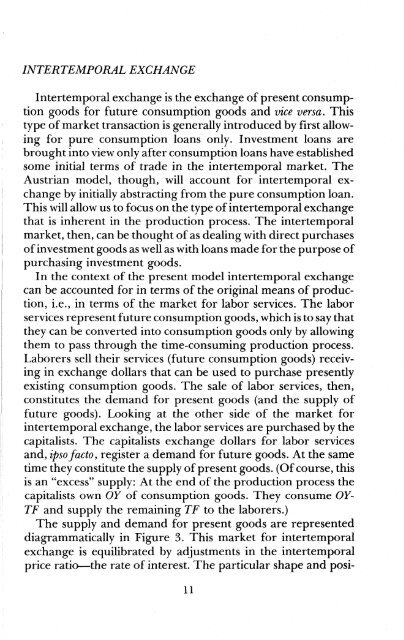Austrian Macroeconomics - Ludwig von Mises Institute
Austrian Macroeconomics - Ludwig von Mises Institute
Austrian Macroeconomics - Ludwig von Mises Institute
You also want an ePaper? Increase the reach of your titles
YUMPU automatically turns print PDFs into web optimized ePapers that Google loves.
INTERTEMPORAL EXCHANGE<br />
Intertemporal exchange is the exchange ofpresent consumption<br />
goods for future consumption goods and vice versa. This<br />
type ofmarket transaction is generally introduced by first allowing<br />
for pure consumption loans only. Investment loans are<br />
brought into view only after consumption loans have established<br />
some initial terms of trade in the intertemporal market. The<br />
<strong>Austrian</strong> model, though, will account for intertemporal exchange<br />
by initially abstracting from the pure consumption loan.<br />
This will allow us to focus on the type ofintertemporal exchange<br />
that is inherent in the production process. The intertemporal<br />
market, then, can be thought ofas dealing with direct purchases<br />
ofinvestment goods as well as with loans made for the purpose of<br />
purchasing investment goods.<br />
In the context of the present model intertemporal exchange<br />
can be accounted for in terms of the original means of production,<br />
i.e., in terms of the market for labor services. The labor<br />
services represent future consumption goods, which is to say that<br />
they can be converted into consumption goods only by allowing<br />
them to pass through the time-consuming production process.<br />
Laborers sell their services (future consumption goods) receiving<br />
in exchange dollars that can be used to purchase presently<br />
existing consumption goods. The sale of labor services, then,<br />
constitutes the demand for present goods (and the supply of<br />
future goods). Looking at the other side of the market for<br />
intertemporal exchange,the labor services are purchased by the<br />
capitalists. The capitalists exchange dollars for labor services<br />
and, ipso facto, register a demand for future goods. At the same<br />
time they constitute the supply ofpresent goods. (Ofcourse, this<br />
is an "excess" supply: At the end of the production process the<br />
capitalists own oy of consumption goods. They consume oy<br />
TF and supply the remaining TF to the laborers.)<br />
The supply and demand for present goods are represented<br />
diagrammatically in Figure 3. This market for intertemporal<br />
exchange is equilibrated by adjustments in the intertemporal<br />
price ratio-the rate of interest. The particular shape and posi-<br />
11

















